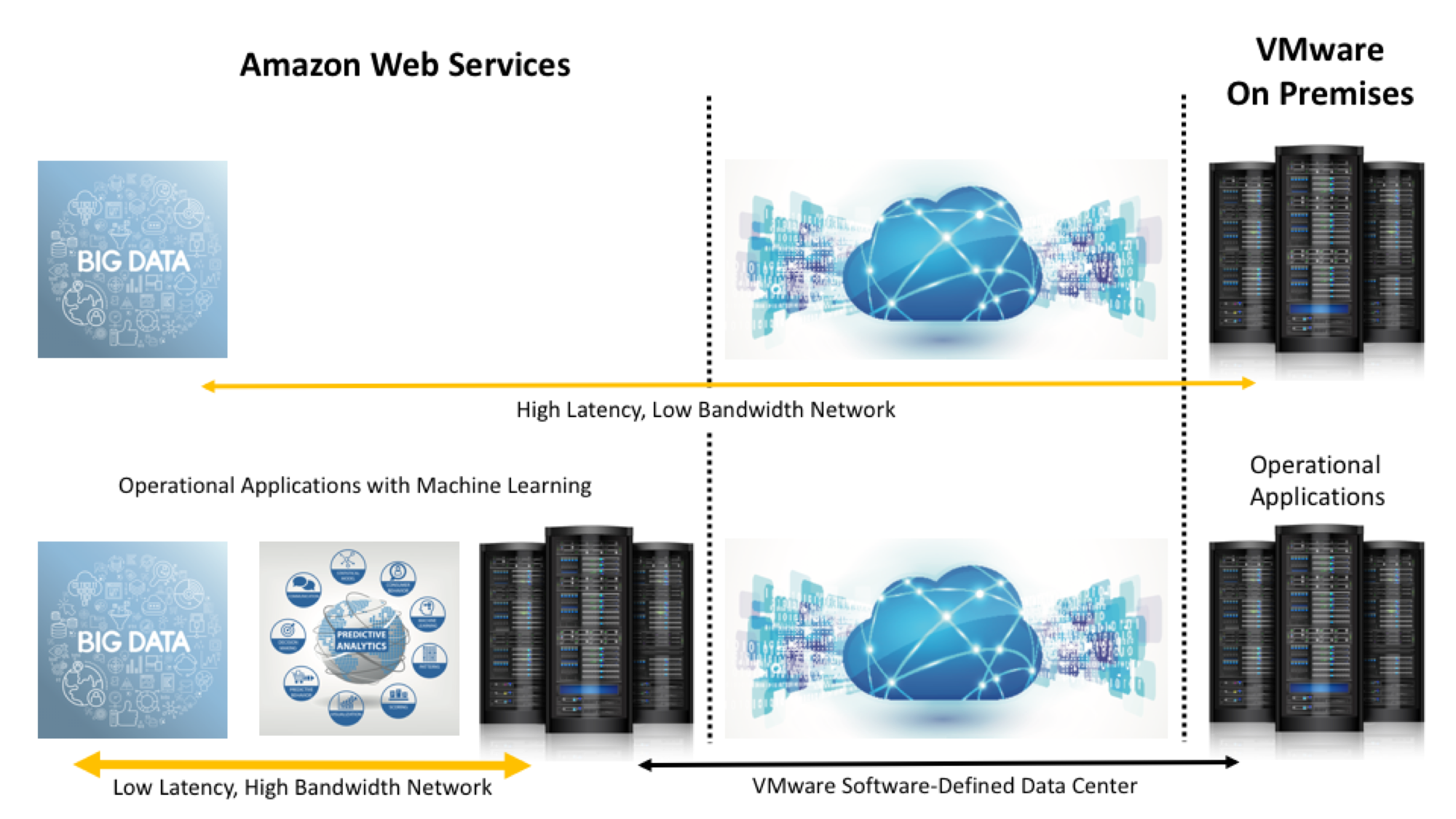Premise. The limited integration of management capabilities between VMware workloads and native AWS services obscures a much bigger potential win for customers: the ability to migrate mission-critical OLTP workloads from VMware on-premises to VMware running on AWS will catalyze a new round of application innovation, making the addition of real-time advanced analytics much easier. The two trends will feed on each other via powerful network effects.
Who says you can’t teach old dogs new tricks? Traditional OLTP applications, the foundational apps for business operations, have lived mainly on-premises. Investing the resources to run these applications on VMware over the last 5-10 years made them more hardware-efficient and easier to migrate across clusters of servers. More recently, machine learning has emerged with the ability to anticipate and influence customer interactions as well as drive better operational decisions. But machine learning uses big data and that data is increasingly accumulating in public clouds, led by AWS. Once VMware is able to run on AWS, operational applications previously bound on-premises will be able migrate seamlessly to the public cloud. When big data and operational applications are co-located, machine learning will make it possible to transform both traditional and new applications (See Figure 1) because:
- A critical mass of big data is accumulating in the public cloud. Data attracts more data. Why? Because once you start combining data to create derivative sources of value, it’s hard to stop. The public cloud is emerging as a natural big data accumulation point.
- Running VMware on AWS will bring operational applications to the public cloud. Operational applications have been getting steadily more “movable” as enterprises host them on VMware infrastructure. With VMware running on AWS, the applications will finally have an easy migration path to the public cloud.
- Co-locating big data and operational applications will unlock a new generation of machine learning applications. Machine learning applications become possible when operational applications and big data are co-located. The latency involved in moving data or analytics goes away.

A Critical Mass Of Data Is Accumulating In The Public Cloud.
Data is collecting in the public cloud. Data from more sources, including Web sites, mobile devices, IoT, third party feeds, and other applications is flowing into the public cloud ever faster. A feedback loop drives this phenomenon: data attracts more data. A critical mass of data makes it possible for data to be combined and recombined for use in the right context in real-time. Take airlines as an example. They have to manage complex operations where one event can cause ripple effects across hundreds of flights. For example, The Weather Company, which IBM bought last year and runs in IBM’s cloud, offers an application for airlines to improve operations planning. This application combines real-time information from many sources including weather information from satellites, thousands of ground stations, and millions of mobile devices, including ones in the planes themselves as well as airspace status. GE’s Predix service collects data on aircraft engine performance from thousands of sensors on each engine. Predix analyzes this data in order to minimize unplanned downtime through proactive maintenance. The airlines themselves use operations management applications, such as those from Sabre, to manage flight and crew schedules based on information such as fleet data and airport traffic. Combining and recombining the data from these applications will enable new and higher value usage scenarios. A simple example might combine a predicted weather-related disruption to flight schedules with predictive maintenance requirements. An airline could reschedule fleet maintenance, flights, crews, and issue notifications to passengers in real-time.
Traditionally, deciding what data to retain, from what sources, and in what format took careful planning. Today, the incredibly difficult challenge of designing up front a data warehouse with all the expected questions no longer constrains many of those decisions about data retention. Rather, enterprises can collect everything in a data lake and decide what questions to ask after discovering what’s available. This batch process of discovery and predictive analysis can happen when designing applications as well as at runtime. But the predictive analysis process can also happen when the data is arriving in real-time as well. In either scenario, the analytics have to come to the data. Moving big data or combining real-time data from many sources has to happen at a central location. Otherwise the latency in getting answers would greatly diminish the value.
Running VMware on AWS Will Bring Operational Applications To The Public Cloud
With steady improvements in performance, efficiency, and manageability over the last 5-10 years, customers have moved more and more operational applications to VMware. And VMware has made these applications steadily more migrate-able. With the AWS partnership, the software-defined data center now extends beyond the boundaries of on-premises infrastructure. vCenter, VMware’s basic management software, can manage and migrate applications that run on a cluster of servers from a customer’s premises to AWS as easily as moving to another local cluster.
Getting VMware to be able to support this level of migration has taken painstaking improvements over more than a decade. At first, applications could only migrate between servers sharing the same storage, such as a SAN or NAS device, as well as the same network segment. vSAN software eliminated the shared storage requirement. And, more recently, NSX allowed customers to define virtual networks with the same security and flexibility as if they were physically configured. With all those pieces in place, the boundaries between applications on customers’ data centers and AWS is in the vCenter management software.
Co-Locating Big Data and Operational Apps Will Unlock A New Generation Of Machine Learning Applications
A generational advance in applications is arriving. With VMware running on AWS, enterprises can migrate existing operational applications to the public cloud. This centralized location makes it possible for existing and new applications to leverage machine learning using co-located big data and analytics.
Several traditional barriers are falling away. Petabytes of data from all sorts of sources are collecting in the public cloud. That data can’t travel to customers’ on-premises operational applications for analysis in their private data centers over existing, relatively low bandwidth networks. The applications have to come to the data. Not only does analysis in the public cloud eliminate most of the latency that would exist with on-premises applications, but the cloud provides much easier access to elastic capacity that analysis. One significant unknown remains with VMware running on AWS: getting data out of AWS has traditionally been expensive. It’s not yet clear if AWS will price bandwidth to co-located VMware as inexpensively as the bandwidth natively within AWS.


